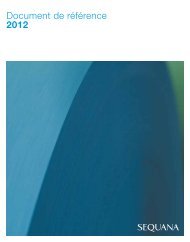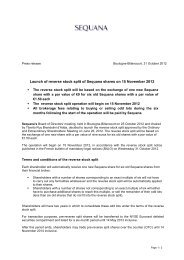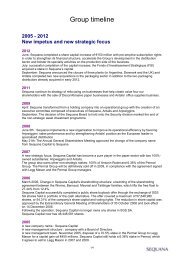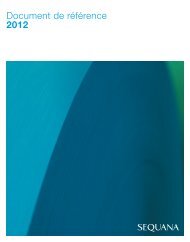Contents
Registration document PDF - Sequana
Registration document PDF - Sequana
Create successful ePaper yourself
Turn your PDF publications into a flip-book with our unique Google optimized e-Paper software.
4Financial position – resultsNotes to the consolidated financial statementsSensitivity of assumptionsOn all employee benefit obligations(€ millions)Benchmarkdiscount rate -0.50%Benchmarkdiscount rateBenchmarkdiscount rate +0.50%Fair value of benefit obligation at 31 December 2012 1,426 1,316 1,215Service cost for 2013 14 12 11On UK and US employee benefit obligations only(€ millions)Benchmarkdiscount rate -0.50%Benchmarkdiscount rateBenchmarkdiscount rate +0.50%Fair value of benefit obligation at 31 December 2012 1,005 1,070 1,143Service cost for 2013 5 6 6Sensitivity of healthcare benefit obligationsto a 1% increase/decrease in medical costsA 1% increase/decrease in medical costs would not have a materialimpact on the Group’s benefit obligations at 31 December 2012or on the service cost for 2013.Estimated contributions for 2013The amount of contributions payable by the Group in respect ofpension benefit obligations for 2013 is estimated at €36 million,of which €32 million relates to the UK.Impacts of the transition to the amended IAS 19The amended IAS 19 published in June 2011 was adopted by theEuropean Union in June 2012 and is effective from 2013 at thelatest. Accordingly, Sequana must apply the new rules introducedby the amended standard as from 2013.Since application of the amended IAS 19 is retrospective, IAS 8requires first-time application as of the start of the earliest priorperiod presented, i.e., 1 January 2012 in the 2013 consolidatedfinancial statements.The application of the amended IAS 19 would have had the followingimpacts on the 2012 consolidated financial statements:■■at 1 January 2012, the recognition of any existing unrecognisedpast service cost against equity would have resulted in a loss of€0.7 million;■■changes to the method of calculating the return on planassets would have resulted in an additional expense of around€6.7 million in the income statement, offset by gains for thesame amount in equity;■■no material impact would have resulted from expensing taxesand administration costs since the main expense items hadalready been provisioned/recognised in accordance with theamended standard.Actuarial gains and losses must be recognised directly in equity(other comprehensive income) under the amended standard.Since this method was already applied by Sequana prior to thestandard’s publication, this change would have had no impact onthe consolidated financial statements.Return on plan assetsUnder the amended IAS 19, the expected return on plan assetsused to calculate pension cost for 2013 is equal to the discount rate.Impact of the application of IFRIC 14In accordance with IFRIC 14, as of 31 December 2012:■■The Group booked an additional provision for an onerousobligation on the McNaughton Papers and Modo Merchantsdefined benefit pension plans in the UK for which no surpluswill accrue to the employer. Based on the present value of theprojected funding requirements for the two pension plan deficits,€11.7 million was booked for McNaughton Papers and€3.4 million for Modo Merchants.Discount ratesDiscount rates for each monetary zone were determined basedon yields at 31 December 2012 on high quality corporate bondsrated AA or above, with maturities that correspond to the averagematurities of the Group’s obligations in each zone.130 | Sequana | 2012 Document de référence (English version)









